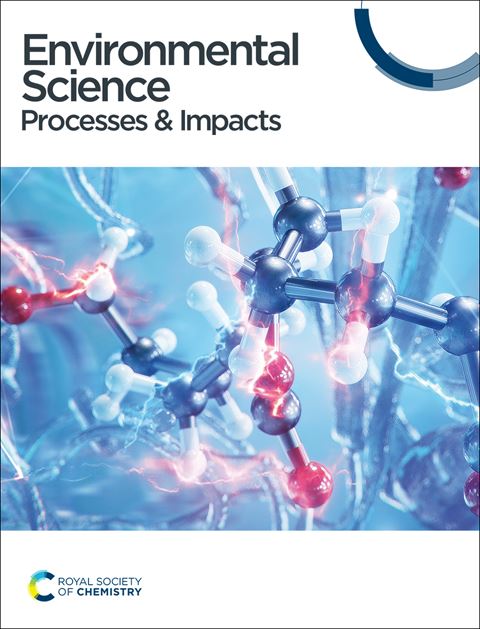The impact of surfaces on indoor air chemistry following cooking and cleaning
IF 4.3
3区 环境科学与生态学
Q1 CHEMISTRY, ANALYTICAL
引用次数: 0
Abstract
Cooking and cleaning are common sources of indoor air pollutants, including volatile organic compounds (VOCs). The chemical fate of VOCs indoors is determined by both gas-phase and multi-phase chemistry, and can result in the formation of potentially hazardous secondary pollutants. Chemical interactions at the gas-surface boundary play an important role in indoor environments due to the characteristically high surface area to volume ratios (SAVs). This study first characterises the VOC emissions from a typical cooking and cleaning activity in a semi-realistic domestic kitchen, using real-time measurements. While cooking emitted a larger amount of VOCs overall, both cooking and cleaning were sources of chemically reactive monoterpenes (peak mixing ratios 7 ppb and 2 ppb, respectively). Chemical processing of the VOC emissions from sequential cooking and cleaning activities was then simulated in a kitchen using a detailed chemical model. Results showed that ozone (O3) deposition was most effective onto plastic and soft furnishings, while wooden surfaces were the most effective at producing formaldehyde following multi-phase chemistry. Subsequent modelling of cooking and cleaning emissions using a range of measured kitchen SAVs revealed that indoor oxidant levels and the subsequent chemistry, are strongly influenced by the total and material-specific SAV of the room. O3 mixing ratios ranged from 1.3–7.8 ppb across 9 simulated kitchens, with higher concentrations of secondary pollutants observed at higher O3 concentration. Increased room volume, decreased total SAV, decreased SAVs of plastic and soft furnishings, and increased wood SAV contributed to elevated formaldehyde and total peroxyacetyl nitrates (PANs) mixing ratios, of up to 1548 ppt and 643 ppt, respectively, following cooking and cleaning. Therefore, the size and material composition of indoor environments has the potential to impact the chemical processing of VOC emissions from common occupant activities.

烹饪和清洁后表面对室内空气化学的影响
烹饪和清洁是室内空气污染物(包括挥发性有机化合物)的常见来源。挥发性有机化合物在室内的化学归宿由气相和多相化学决定,并可能形成具有潜在危害的二次污染物。由于室内环境的表面积与体积比(SAV)较高,因此气表边界的化学相互作用在室内环境中发挥着重要作用。本研究首先采用实时测量方法,描述了在一个半真实的家庭厨房中进行典型烹饪和清洁活动时的挥发性有机化合物排放特征。虽然烹饪排放的挥发性有机化合物总量较大,但烹饪和清洁都是化学反应性单萜烯的来源(峰值混合比分别为 7 ppb 和 2 ppb)。然后,使用详细的化学模型模拟了厨房中连续烹饪和清洁活动所排放的挥发性有机化合物的化学处理过程。结果显示,臭氧(O3)沉积在塑料和软家具上最有效,而木质表面在多相化学作用下产生甲醛的效果最好。利用一系列测量的厨房 SAV 对烹饪和清洁排放物进行的后续建模显示,室内氧化剂水平和随后的化学反应受到房间总 SAV 和特定材料 SAV 的强烈影响。在 9 个模拟厨房中,O3 混合比在 1.3-7.8 ppb 之间,O3 浓度越高,二次污染物浓度越高。烹饪和清洁后,房间容积增加、总 SAV 减少、塑料和软家具的 SAV 减少以及木材 SAV 增加,导致甲醛和总过氧乙酰硝酸盐 (PANs) 混合比升高,分别高达 1548 ppt 和 643 ppt。因此,室内环境的大小和材料构成有可能影响到普通居住活动所排放的挥发性有机化合物的化学处理。
本文章由计算机程序翻译,如有差异,请以英文原文为准。
求助全文
约1分钟内获得全文
求助全文
来源期刊

Environmental Science: Processes & Impacts
CHEMISTRY, ANALYTICAL-ENVIRONMENTAL SCIENCES
CiteScore
9.50
自引率
3.60%
发文量
202
审稿时长
1 months
期刊介绍:
Environmental Science: Processes & Impacts publishes high quality papers in all areas of the environmental chemical sciences, including chemistry of the air, water, soil and sediment. We welcome studies on the environmental fate and effects of anthropogenic and naturally occurring contaminants, both chemical and microbiological, as well as related natural element cycling processes.
 求助内容:
求助内容: 应助结果提醒方式:
应助结果提醒方式:


